Starfish
| Sea Stars Temporal range:
| |
|---|---|
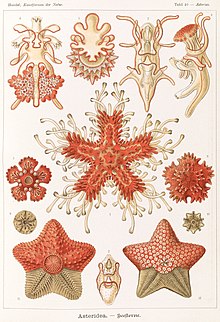
| |
| "Asteroidea" from Ernst Haeckel's Kunstformen der Natur, 1904 | |
| Scientific classification | |
| Kingdom: | |
| Phylum: | |
| Subphylum: | |
| Class: | Asteroidea De Blainville, 1830
|
| Orders | |
|
Brisingida (100 species[1]) | |
Starfish or sea stars are echinoderms belonging to the class Asteroidea.[2] The names "starfish" and "sea star" essentially refer to members of the class Asteroidea. However, common usage frequently finds "starfish" and "sea star" also applied to ophiuroids which are correctly referred to as "brittle stars" or "basket stars".
There are about 1,800 living species of starfish that occur in all the world's oceans, including the Atlantic, Pacific, Indian as well as in the Arctic and the Southern Ocean (i.e., Antarctic) regions. Starfish occur across a broad depth range from the intertidal to abyssal depths (>6000 m).
Starfish are among the most familiar of marine animals and possess a number of widely known traits, such as regeneration and feeding on mussels. Starfish possess a wide diversity of body forms and feeding methods. The extent that Asteroidea can regenerate varies with individual species. Broadly speaking, starfish are opportunistic feeders, with several species having specialized feeding behavior, including suspension feeding and specialized predation on specific prey.
The Asteroidea occupy several important roles throughout ecology and biology. Sea stars, such as the Ochre sea star (Pisaster ochraceus) have become widely known as the example of the keystone species concept in ecology. The tropical Crown of Thorns starfish (Acanthaster planci) are voracious predators of coral throughout the Indo-Pacific region. Other starfish, such as members of the Asterinidae, are frequently used in developmental biology.
Appearance


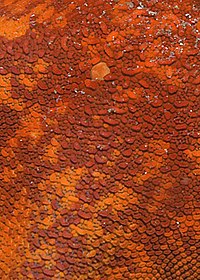
Starfish express pentamerism or pentaradial symmetry as adults. However, theoretically, the evolutionary ancestors of echinoderms are believed to have had bilateral symmetry. Starfish, as well as other echinoderms, do exhibit bilateral symmetry, but only as larval forms.[3]
Most starfish typically have five rays or arms, which radiate from a central disk. However, several species frequently have six or more arms. Several asteroid groups, such as the Solasteridae, have 10-15 arms whereas some species, such as the Antarctic Labidiaster annulatus can have up to 50. It is not unusual for species that typically have five-rays to exceptionally possess six or more rays due to developmental abnormalities.[4]
The bodies of starfish are composed of calcium carbonate components, known as ossicles. These form the endoskeleton, which takes on a variety of forms that are externally expressed as a variety of structures, such as spines and granules. The architecture and individual shape/form of these plates which often occur in specific patterns or series, as well as their location are the source of morphological data used to classify the different groups within the Asteroidea. Terminology referring to body location in sea stars is usually based in reference to the mouth to avoid incorrect assumptions of homology with the dorsal and ventral surfaces in other bilateral animals. The bottom surface is often referred to as the oral or actinal surface whereas the top surface is referred to as the aboral or abactinal side.
The body surface of sea stars often has several structures that comprise the basic anatomy of the animal and can sometimes assist in its identification.
The madreporite can be easily identified as the light-colored circle, located slightly off center on the central disk. This is a porous plate which is connected via a calcified channel to the animal's water vascular system in the disk. Its function is, at least in part, to provide additional water for the animal's needs, including replenishing water to the water vascular system.
Several groups of asteroids, including the Valvatacea but especially the Forcipulatacea possess small bear-trap or valve-like structures known as pedicellariae. These can occur widely over the body surface. In forcipulate asteroids, such as Asterias or Pisaster, pedicellariae occur in pom-pom like tufts at the base of each spine, whereas in goniasterids, such as Hippasteria, pedicellariae are scattered over the body surface. Although the full range of function for these structures is unknown, some are thought to act as defense where others have been observed to aid in feeding. The Antarctic Labidiaster annulatus uses its large, pedicellariae to capture active krill prey. The North Pacific Stylasterias has been observed to capture small fish with its pedicellariae.
Other types of structures vary by taxon. For example, Porcellanasteridae employ additional cribriform organs which occur among their lateral plate series, which are thought to generate current in the burrows made by these infaunal sea star.[5]
Internal anatomy

1 - Pyloric stomach 2 - Intestine and anus 3 - Rectal sac 4 - Stone canal 5 - Madreporite 6 - Pyloric caecum 7 - Digestive glands 8 - Cardiac stomach 9 - Gonad 10 - Radial canal 11 - Tube feet
As echinoderms, starfish possess a hydraulic water vascular system that aids in locomotion.[6] The water vascular system has many projections called tube feet on the ventral face of the sea star's arms which function in locomotion and aid with feeding. Tube feet emerge through openings in the endoskeleton and are externally expressed through the open grooves present along the bottom of each arm.
The body cavity not only contains the water vascular system that operates the tube feet, but also the circulatory system, called the hemal system. Hemal channels form rings around the mouth (the oral hemal ring), closer to the top of the sea star and around the digestive system (the gastric hemal ring).[7] A portion of the body cavity called the axial sinus connects the three rings. Each ray also has hemal channels running next to the gonads.
On the end of each arm or ray there is a microscopic eye (ocellus), which allows the sea star to see, although it only allows it to see light and dark, which is useful to see movement.[8] Only part of the cells are pigmented (thus a red or black color) and there is no cornea or iris. This eye is known as a pigment spot ocellus.[9]
Several types of toxins and secondary metabolites have been extracted from several species of sea star. Research into the efficacy of these compounds for possible pharmacological or industrial use occurs worldwide.
Digestive system
The mouth of a starfish is located on the underside of the body, and opens through a short esophagus into firstly a cardiac stomach, and then, a second, pyloric stomach. Each arm also contains two pyloric caeca, long hollow tubes branching outwards from the pyloric stomach. Each pyloric caecum is lined by a series of digestive glands, which secrete digestive enzymes and absorb nutrients from the food. A short intestine runs from the upper surface of the pyloric stomach to open at an anus in the center of the upper body.[10]
Many sea stars, such as Astropecten and Luidia swallow their prey whole, and start to digest it in the stomachs before passing it into the pyloric caeca.[10] However, in a great many species, the cardiac stomach can be everted out of the organism's body to engulf and digest food. In these species, the cardiac stomach fetches the prey then passes it to the pyloric stomach, which always remains internal.[11]
Some species are able to use their water vascular systems to force open the shells of bivalve molluscs such as clams and mussels by injecting their stomachs into the shells. With the stomach inserted inside the shell, the sea star is able to digest the mollusc in place. The cardiac stomach is then brought back inside the body, and the partially digested food is moved to the pyloric stomach.[12] Further digestion occurs in the intestine. Waste is excreted through the anus on the aboral side of the body.[13]
Because of this ability to digest food outside of its body, the sea star is able to hunt prey that are much larger than its mouth would otherwise allow, such as clams and oysters, arthropods, small fish, and molluscs. However, some species are not pure carnivores, and may supplement their diet with algae or organic detritus. Some of these species are grazers, but others trap food particles from the water in sticky mucus strands that can be swept towards the mouth along ciliated grooves.[10]
Some echinoderms can live for several weeks without food under artificial conditions. Scientists believe that they may receive some nutrients from organic material dissolved in seawater.
Nervous system
Echinoderms have rather complex nervous systems, as well as centralized brain. All echinoderms have a network of interlacing nerves called a nerve plexus which lies within, as well as below, the skin.[14] The esophagus is also surrounded by a central nerve ring which sends radial nerves into each of the arms, often parallel with the branches of the water vascular system. These all connect toghther to form a brain. The ring nerves and radial nerves coordinate the sea star's balance and directional systems.[citation needed]
Although the echinoderms do not have many well-defined sensory inputs, they are sensitive to touch, light, temperature, orientation, and the status of water around them.[15] The tube feet, spines, and pedicellariae found on sea stars are sensitive to touch, while eyespots on the ends of the rays are light-sensitive.[16] The tube feet, especially those at the tips of the rays, are also sensitive to chemicals and this sensitivity is used in locating odor sources, such as food.[17]
The eyespots each consist of a mass of ocelli, consisting of pigmented epithelial cells that respond to light and narrow sensory cells lying between them. Each ocellus is covered by a thick, transparent, cuticle that both protects them and acts as a lens. Many starfish also possess individual photoreceptor cells across their body and are able to respond to light even when their eyespots are covered.[10]
Locomotion

Sea stars move using a water vascular system. Water comes into the system via the madreporite. It is then circulated from the stone canal to the ring canal and into the radial canals. The radial canals carry water to the ampulla portion of tube feet.
Tube feet consist of internal ampulla and external podium, or "foot". The ampulla squeezes forcing water into podium, which expands to contact substrate. Although the podium resembles a suction cup, gripping action is a function of adhesive chemicals rather than suction. De-adhesive chemicals and podial contraction allow for the release off of substrate.[18]
The tube feet latch on to surfaces and move in a wave, with one body section attaching to the surfaces as another releases. Most sea stars cannot move quickly. However, some burrowing species from the genera Astropecten and Luidia are capable of rapid, creeping motion: "gliding" across the ocean floor [citation needed]. This motion results from their pointed tubefeet adapted specially for excavating patches of sand [citation needed].
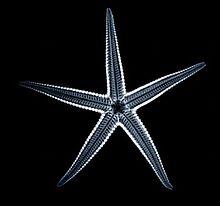
Endoskeleton
Sea stars, like other echinoderms have mesodermal endoskeletons consisting of small calcareous ossicles (bony plates).
Respiration and excretion
Respiration occurs mainly through the tube feet, and through tiny structures called papullae that dot the body surface. These papullae are thin-walled projections of the body cavity, reaching through the muscular body wall and into the surrounding water. Oxygen from the water is distributed through the body mainly by the fluid in the main body cavity; the hemal system may also play a minor role.[10]
Excretion of nitrogenous waste is also performed through the tube feet and papullae, and there are no distinct excretory organs. The body fluid contains phagocytic cells called coelomocytes, which are also found within the hemal and water vascular systems. These cells engulf waste material, and eventually migrate to the tips of the papullae where they are ejected into the surrounding water. Some waste may also be excreted by the pyloric glands and voided with the faeces.[10]
Starfish do not appear to have any mechanisms for osmoregulation, and keep their body fluids at the same salt concentration as the surrounding water. Although some species can tolerate relatively low salinity, the lack of osmoregulation likely explains why starfish are not found in fresh water, or even in estuarine environments.[10]
Life cycle
Starfish are capable of both sexual and asexual reproduction.
Sexual reproduction
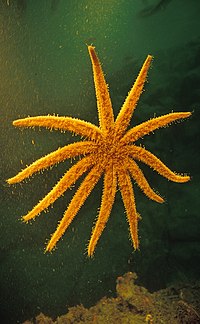
Most species are dioecious, with separate male and female individuals (also referred to as gonochoric). Male and female sea stars are usually not distinguishable from the outside; one needs to see the gonads or be lucky enough to catch them spawning. Some species are simultaneous hermaphrodites (producing eggs and sperm at the same time). In a few of these the same gonad (called an ovotestes[19]) produces eggs and sperm. Yet other sea stars are sequential hermaphrodites with some species being protandrous i.e. young individuals are males that change into females as they grow larger. (e.g. Asterina gibbosa ) and others protogynous. In some of these species, when a large female divides, the smaller individuals produced become males. When they grow big enough they change back into females.[20]
Each arm contains two gonads, which release gametes through openings called gonoducts, located on the central body between the arms.
Fertilization is external in most species though a few show internal fertilization. In most species the buoyant eggs and sperm are simply released into the water (free spawning) and the resulting embryos and larvae live as part of the plankton. In others the eggs may be stuck onto the underside of rocks to develop.[21] Certain species of sea star brood their eggs - either by simply sitting on them[21] or by holding them in specialised structures. These structures include chambers on their aboral surface,[22] the pyloric stomach(Leptasterias tenera)[23] or even the gonads themselves.[19] Those sea stars that brood their eggs by sitting on them usually raise their disc and assume a humped posture.[24] One species broods a few of its young and broadcasts the remaining eggs which wont fit into the pouch.[22] In these brooding species, the eggs are relatively large, and supplied with yolk, and they generally (but not always[19]) develop directly into miniature starfish, without a larval stage. The developing young are called lecithotrophic because they get their nutrition from the yolk as opposed to planktotrophic feeding larvae. In one species of intragonadal brooder the young starfish get their nutrition by eating the eggs and embryos with them in their gonadal brood pouch.[25] Brooding is especially common in polar and deep-sea species, environments less favourable for larvae[10][23] and in smaller species that produce few eggs.[26]
To increase their chances of fertilization, sea stars may synchronize their spawning, gather in groups[21] or form pairs.[27] This is called pseudo-copulation[28] when the males climb onto the females with their arms placed between those of the female and release the sperm around them. Sea stars may use environmental signals to coordinate timing of spawning (day length to indicate the correct time of the year, dawn or dusk to indicate the correct time of day), and chemical signals to indicate their readiness to each other.[29] In some species mature females produce chemicals that attract sperm in the sea water.[29]
Asexual reproduction
Some species of sea star also reproduce asexually by fragmentation, often with part of an arm becoming detached and eventually developing into an independent individual sea star. Sea stars can be pests to fishermen who make their living on the capture of clams and other mollusks at sea as sea stars prey on these. The fishermen would think they had killed the sea stars by chopping them up and disposing of them at sea, but each fragment would regenerate into a complete adult, ultimately leading to their increased numbers until the issue was better understood[citation needed]. A sea-star arm can even regenerate into a whole new organism if none of the central disk of the sea star is part of the chopped off arm. Even the tip of an arm can regenerate into a new individual.[30] A starfish which is regenerating from a severed arm, with one full-sized arm and the other arms small, is sometimes called a "comet starfish".[31]
Larval development
Like all echinoderms, starfish are developmentally (embryologically) deuterostomes; a feature they share with chordates (including vertebrates), but not with most other invertebrates. Their embryo initially develops bilateral symmetry, again reflecting their likely common ancestry with chordates. Later development takes a very different path, however, as the developing star fish settles out of the zooplankton and develops the characteristic radial symmetry. As the organism grows, one side of the body grows more than the other, and eventually absorbs the smaller side. After that, the body is formed into five parts around a central axis. Then the echinoderm has radial symmetry.
The larvae of echinoderms are ciliated, free-swimming organisms. Fertilized eggs grow into bipinnaria and (in most cases) later into brachiolaria larvae, which either grow using a yolk or by catching and eating other plankton. In either case, they live as plankton, suspended in the water and swimming by using beating cilia. The larvae are bilaterally symmetric — unlike adults, they have a distinct left and right side. Eventually, they undergo a complete metamorphosis, settle to the bottom, and grow into adults.
Lifespan
The lifespan of starfish varies considerably between species, generally being longer in larger species. For example, Leptasterias hexactis (adult weight 2 grams) reaches sexual maturity in two years, and lives for about ten years in total, while Pisaster ochraceus (adult weight 80 grams) reaches maturity in five years, and may live to the age of 34.[10]
Regeneration
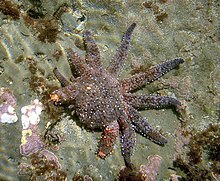
Some species of sea star have the ability to regenerate lost arms and can regrow an entire new arm in time. Sea stars can grow an entire sea star from a single ray, as in the red and blue Linckia star.[32]
Diet

Most species are generalist predators, eating mollusks such as clams, oysters, some snails, or any other animal too slow to evade the attack (e.g. other echinoderms, or dying fish). Some species are detritivores, eating decomposed animal and plant material or organic films attached to substrate. Others may consume coral polyps (the best-known example for this is the infamous Crown-of-thorns starfish), sponges or even suspended particles and plankton (such as sea stars of the Order Brisingida).[33] The processes of feeding and capture may be aided by special parts; Pisaster brevispinus or short-spined pisaster from the West Coast of America may use a set of specialized tube feet to extend itself deep into the soft substrata to extract prey (usually clams).[34] Grasping the shellfish, the sea star slowly pries open the shell by wearing out the adductor muscle and then inserts (also called evisceration) its stomach into an opening to devour the organism.
Distribution
There are about 1,800 known living species of sea star, and they occur in all of the Earth's oceans. The greatest variety of sea stars is found in the tropical Indo-Pacific. Areas known for their great diversity include the tropical-temperate regions around Australia, the tropical East Pacific, and the cold-temperate water of the North Pacific (California to Alaska). Asterias is a common genus found in European waters and on the eastern coast of the United States; Pisaster, along with Dermasterias ("leather star"), are usually found on the western coast. Habitats range from tropical coral reefs, kelp forests to deep-sea floor, although none of them live within the water column; all species of sea star found are living as benthos. Echinoderms need a delicate internal balance in their body; no sea stars are found in freshwater environments.
Diversity

As mentioned above, there are over 1,800 species; with many species awaiting discovery. Some of the better known sea stars would include:
- Bat star
- Blue sea star
- Carpet sea star
- Comb sea star
- Common starfish
- Crown-of-thorns sea star
- Eleven-armed sea star
- Japanese sea star
- Ochre sea star
- Pincushion sea star
- Pink sea star
- Horned sea star
The Northern Pacific sea star (Asterias amurensis) known as gohongaze is considered an edible delicacy.[35]
Threats
Sea stars and other echinoderms pump water directly into their bodies, via the water vascular system, as they find it. This makes them vulnerable to all forms of water pollution, as they have little ability to filter the water of toxins and contaminants. Oil spills and similar events often take a toll on echinoderm populations that carry consequences for the ecosystem.[36]

Notes
- ^ a b c d e f g Sweet, Elizabeth (22 November 2005). "Asterozoa: Fossil groups: SciComms 05-06: Earth Sciences". Retrieved 7 May 2008.
- ^ Mooi, Rich. "Classification of the Extant Echinodermata." California Academy of Sciences - Research. <http://research.calacademy.org/research/izg/echinoderm/classify.htm>.
- ^ "Starfish." 16 May 2008. HowStuffWorks.com. <http://animals.howstuffworks.com/marine-life/starfish-info.htm> 16 January 2009.
- ^ You superstar! Fisherman hauls in starfish with eight legs instead of five, Daily Mail, 24 October 2009, accessed 3 January 2010.
- ^ Star Fish." South Central Service Co-op. 2001. <http://www.scsc.k12.ar.us/2001Outwest/PacificNaturalHistory/Projects/ReynoldsJ/Default.htm>.
- ^ "Wonders of the Sea: Echinoderms." Ceanside Meadows Institute for the Arts and Sciences. <http://www.oceaninn.com/guides/echino.htm>.
- ^ "Sea stars on Chek Jawa, Pulau Ubin, Singapore." Wildsingapore. <http://www.wildsingapore.org/chekjawa/text/p610.htm>.
- ^ "Animal Eyes." San Diego Natural History Museum—Your Nature Connection in Balboa Park. 31 December 2002. <http://www.sdnhm.org/exhibits/eyes/overview.html>.
- ^ "Eye (invertebrate)" McGraw-Hill Encyclopedia of Science & Technology, vol. 6, p.790 2007
- ^ a b c d e f g h i Barnes, Robert D. (1982). Invertebrate Zoology. Philadelphia, PA: Holt-Saunders International. pp. 939–945. ISBN 0-03-056747-5. Cite error: The named reference "IZ" was defined multiple times with different content (see the help page).
- ^ "Marine Biology Echinodermata - Sea Star." <http://home.earthlink.net/~huskertomkat/star.html>.
- ^ Nicholson, F. C. "How a Sea Star Gets Its Clam - Science Stories - HighlightsKids.com." HighlightsKids. <http://www.highlightskids.com/Science/Stories/SS0596_howseastargetsclam.asp>.
- ^ Dale, Jonathan. "Starfish Digestion and Circulation." 24 May 2009. Madreporite Nexus. <http://www.madreporite.com/science/digest.htm>.
- ^ "Star Fish" South Central Service Co-op. 2001[dead link]
- ^ "Starfish brains, night length, space radiation." WonderQuest. 18 April 2008
- ^ Dale, Jonathan. "Why Do Starfish Always Have Five Rays?" Madreporite Nexus. 24 May 2009.
- ^ Dale, Jonathan. "Chemosensory Orientation in Asterias forbesi" Madreporite Nexus. 24 May 2009
- ^ Campbell & Reece, Biology, Pearson Cummings, 2008, p. 693 ISBN 0-321-54325-4
- ^ a b c Byrne, Maria (1 April 2005). "Viviparity in the Sea Star Cryptasterina hystera (Asterinidae)--Conserved and Modified Features in Reproduction and Development" (Free full text). Biol Bull. 208 (2): 81–91. doi:10.2307/3593116. PMID 15837957. Retrieved 27 July 2011.
- ^ Ottesen, P. O. (1982). "Divide or broadcast: Interrelation of asexual and sexual reproduction in a population of the fissiparous hermaphroditic seastar Nepanthia belcheri (Asteroidea: Asterinidae)". Marine Biology. 69 (3): 223–233. doi:10.1007/BF00397488. ISSN 0025-3162. Retrieved 27 July 2011.
{{cite journal}}: Unknown parameter|coauthors=ignored (|author=suggested) (help) - ^ a b c Crump, R.G (1983). "The natural history, life history and ecology of the two British species of Asterina" (PDF). Field Stydies. 5: 867–882. Retrieved 27 July 2011.
{{cite journal}}: Unknown parameter|coauthors=ignored (|author=suggested) (help) - ^ a b McClary, D. J. (1989-12). "Reproductive pattern in the brooding and broadcasting sea star Pteraster militaris". Marine Biology. 103 (4): 531–540. doi:10.1007/BF00399585. ISSN 0025-3162. Retrieved 27 July 2011.
{{cite journal}}: Check date values in:|date=(help); Unknown parameter|coauthors=ignored (|author=suggested) (help) - ^ a b HENDLER, GORDON (1 June 1982). "THE BIOLOGY OF A BROODING SEASTAR, LEPTASTERIAS TENERA, IN BLOCK ISLAND SOUND" (Free full text). Biol Bull. 162 (3): 273–289. doi:10.2307/1540983. Retrieved 27 July 2011.
{{cite journal}}: Unknown parameter|coauthors=ignored (|author=suggested) (help) - ^ CHIA, FU-SHIANG (1 June 1966). "BROODING BEHAVIOR OF A SIX-RAYED STARFISH, LEPTASTERIAS HEXACTIS" (Free full text). Biol Bull. 130 (3): 304–315. doi:<p></p>. Retrieved 27 July 2011.
{{cite journal}}: Check|doi=value (help) - ^ Byrne, M. (1996). "Viviparity and intragonadal cannibalism in the diminutive sea stars Patiriella vivipara and P. parvivipara (family Asterinidae)". Marine Biology. 125 (3): 551–567. ISSN 0025-3162.
- ^ Strathmann, Richard R. (1 June 1984). "Does Limited Brood Capacity Link Adult Size, Brooding, and Simultaneous Hermaphroditism? A Test with the Starfish Asterina phylactica". The American Naturalist. 123 (6): 796–818. doi:10.1086/284240. ISSN 0003-0147. JSTOR 2460901.
{{cite journal}}: Unknown parameter|coauthors=ignored (|author=suggested) (help) - ^ Run, J. -Q. (1988-09). "Mating behaviour and reproductive cycle of Archaster typicus (Echinodermata: Asteroidea)". Marine Biology. 99 (2): 247–253. doi:10.1007/BF00391987. ISSN 0025-3162. Retrieved 28 July 2011.
{{cite journal}}: Check date values in:|date=(help); Unknown parameter|coauthors=ignored (|author=suggested) (help) - ^ Keesing, John K. (2011-02). "Synchronous aggregated pseudo-copulation of the sea star Archaster angulatus Müller & Troschel, 1842 (Echinodermata: Asteroidea) and its reproductive cycle in south-western Australia". Marine Biology. 158 (5): 1163–1173. doi:10.1007/s00227-011-1638-2. ISSN 0025-3162. Retrieved 28 July 2011.
{{cite journal}}: Check date values in:|date=(help); Unknown parameter|coauthors=ignored (|author=suggested) (help) - ^ a b Miller, Richard L. (12 October 1989). "Evidence for the presence of sexual pheromones in free-spawning starfish". Journal of Experimental Marine Biology and Ecology. 130 (3): 205–221. doi:16/0022-0981(89)90164-0. ISSN 0022-0981. Retrieved 28 July 2011.
{{cite journal}}: Check|doi=value (help) - ^ Autotomy and Regeneration in Hawaiian Starfish
- ^ http://www.australia-downunder-productions.com/popuphoriz.php?&intImageID=3222&varPageTitle=Stock%20Photos:%20Image%20ID:%20080411.084%20--%20Underwater%20pictures%20of%20Comet%20Starfish%20-%20Asexual%20Reproduction%20via%20Fission
- ^ Edmondson, Charles Howard (1935). "Autotomy and Regeneration in Hawaiian Starfishes" (PDF). Bernice P. Bishop Museum - Occasional Papers. 11 (8): 6–12.
- ^ Dale, Jonathan. "Starfish Ecology." Madreporite Nexus. 24 May 2009. <http://www.madreporite.com/science/ecology.htm>.
- ^ Nybakken Marine Biology: An Ecological Approach, Fourth Edition, page 174. Addison-Wesley Educational Publishers Inc., 1997.
- ^ "Cooking Starfish In Japan". Retrieved 7 May 2008.
- ^ http://ocean.si.edu/blog/invisible-loss-impacts-oil-you-do-not-see/
References
- Blake DB, Guensburg TE; Implications of a new early Ordovician asteroid (Echinodermata) for the phylogeny of Asterozoans; Journal of Paleontology, 79 (2): 395-399; MAR 2005.
- Gilbertson, Lance; Zoology Lab Manual; McGraw Hill Companies, New York; ISBN 0-07-237716-X (fourth edition, 1999).
- Shackleton, Juliette D.; Skeletal homologies, phylogeny and classification of the earliest asterozoan echinoderms; Journal of Systematic Palaeontology; 3 (1): 29-114; March 2005.
- Solomon, E.P., Berg, L.R., Martin, D.W. 2002. Biology, Sixth Edition.
- Sutton MD, Briggs DEG, Siveter DJ, Siveter DJ, Gladwell DJ; A starfish with three-dimensionally preserved soft parts from the Silurian of England; Proceedings of the Royal Society B - Biological Sciences; 272 (1567): 1001-1006; MAY 22 2005.
- Hickman C.P, Roberts L.S, Larson A., l'Anson H., Eisenhour D.J.; Integrated Principles of Zoology; McGraw Hill; New York; ISBN 0-07-111593-5 (Thirteenth edition; 2006).
External links
- From the Tree of Life project
- Classification of the Extant Echinodermata
- Starfish–Sea Stars Home Page
- Photos of Sea Stars
- [1]-Damage to sea stars and other Echinoderms that is caused by oil pollution.
Gallery
-
Large red starfish found in Komodo National Park, Indonesia.
-
Sea star from Komodo National Park, Indonesia.
-
Blue starfish in Papua New Guinea.
-
Bat star, Patiria miniata.
-
Ochre sea star, Pisaster ochraceus, on beach at Olympic National Park, USA.
-
Pisaster giganteus, the giant sea star.
-
The tube feet can be seen on this starfish.
-
Caribbean seastar (Oreaster reticulatus), Bahia de la Chiva, Vieques, PR.
-
Oreaster reticulatus in Grahams Harbour, San Salvador Island, Bahamas
-
Pacific Ocean, Cannon Beach, Oregon, US.

















